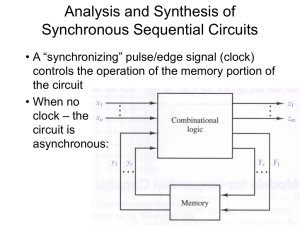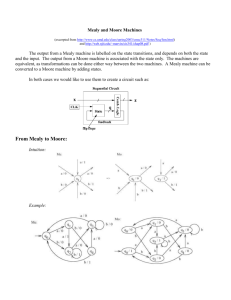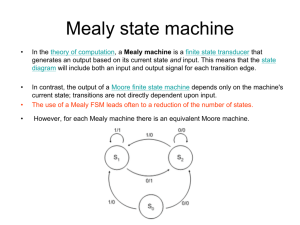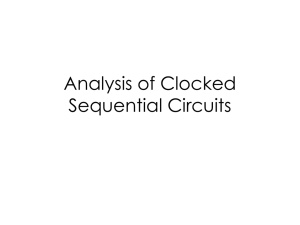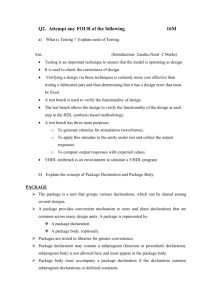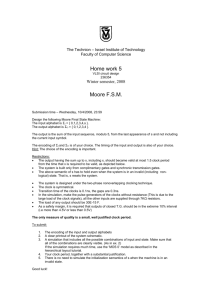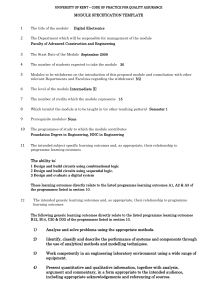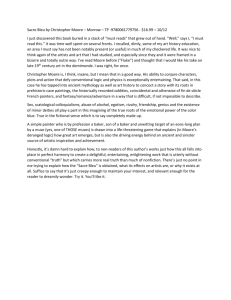week2_2
advertisement
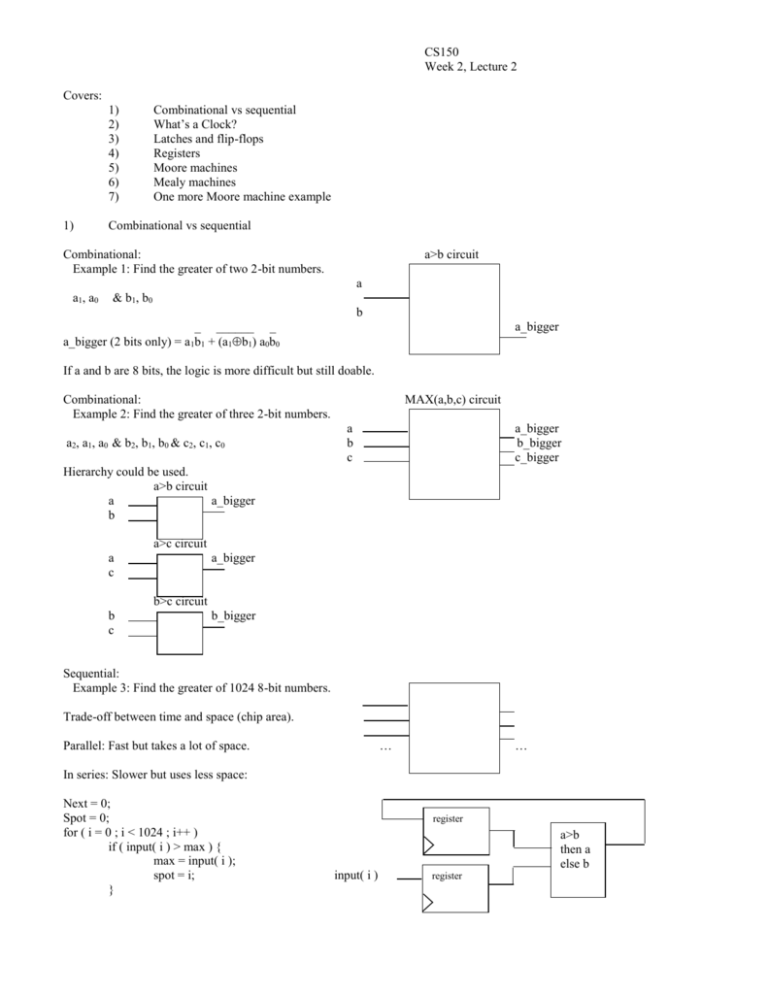
CS150
Week 2, Lecture 2
Covers:
1)
2)
3)
4)
5)
6)
7)
1)
Combinational vs sequential
What’s a Clock?
Latches and flip-flops
Registers
Moore machines
Mealy machines
One more Moore machine example
Combinational vs sequential
Combinational:
Example 1: Find the greater of two 2-bit numbers.
a>b circuit
a
a1 , a0
& b 1, b 0
b
_ ______ _
a_bigger (2 bits only) = a1b1 + (a1b1) a0b0
a_bigger
If a and b are 8 bits, the logic is more difficult but still doable.
Combinational:
Example 2: Find the greater of three 2-bit numbers.
a2, a1, a0 & b2, b1, b0 & c2, c1, c0
MAX(a,b,c) circuit
a
b
c
a_bigger
b_bigger
c_bigger
Hierarchy could be used.
a>b circuit
a
a_bigger
b
a>c circuit
a
c
a_bigger
b>c circuit
b
c
b_bigger
Sequential:
Example 3: Find the greater of 1024 8-bit numbers.
Trade-off between time and space (chip area).
…
Parallel: Fast but takes a lot of space.
…
In series: Slower but uses less space:
Next = 0;
Spot = 0;
for ( i = 0 ; i < 1024 ; i++ )
if ( input( i ) > max ) {
max = input( i );
spot = i;
}
register
a>b
then a
else b
input( i )
register
Other sequential examples:
Example 4: ATM machine. 4 digit PIN number. Four key pads or memory to remember what’s been entered… (Like a cash
register).
Lab next week: 2 digit input, 4 digit code. Could implement as combinational with (possibly less) gates but shows concept of
trading time for space.
2)
What’s a clock?
Digital signal that provides a sense of time so that operations can be synchronized. Sometimes there’s specific “time”
information in the clock ( e.g. the 15 and 45 second timers in chapter 1). Usually they just provide a well defined
sequence/ordering of events.
3)
Latches and flip-flops
Gate Representation
Unclocked
R
Block Representation Sample Timing
Q
_
Q
S
S
Q
R
_
Q
Outputs
Always
Sampling
????
Clocked
R
Q
_
Q
S
CLK
R
S Q
R
_
Q
Samples
When
Clock is
High
S
Enable
?????
Negative edge triggered
register
Samples on
Falling Edge
register
Samples on
Rising Edge
Positive edge triggered
Excitation table for SR, JK, Toggle and D Flip-flops:
Q
0
0
1
1
Q+
0
1
0
1
S R
0 X
1 0
0 1
X 0
J
0
1
X
X
K T D
X 0 0
X 1 1
1 1 0
0 0 1
????
4)
Registers
Registers are just groups of flipflops.
Might have: Synchronous or asynchronous “clear” or “set” along with input and clock.
D
Q
D
Q
D
Q
D
Q
Clock
5)
Moore machines
Combining Registers with combinational logic to get sequential circuit:
IN
OUT
REG
Combinational
Logic
OUT
IN
Moore Machine:
IN
Combinational
Logic
REG
Output
Logic
Moore machine diagram notation:
Input
State
Outputs
Moore machine Example: Look for the input sequence 110. Output 1 when found.
Start in START state. Output a 0 to say that the pattern hasn’t been found yet.
On the clock tick go to state 0 if input == 1. Else stay in START state. Continue to output 0.
Then go to state 1 if next input == 1. Else go back to START state. Continue to output 0.
Go to state 2 if next input == 0 and output a 1 to say the pattern has been found.
A Moore machine’s output is a function of the state. Only one possible output per state:
Output = F1( State ) = F1( Q )
Next state is a function of present state and input:
Next state = Q+ = F2(Q,input)
Moore finite state machine for sequence detector example:
Input = 1
Input = 1
Input = 0
Input = 0
START
0
State 0
0
State 1
0
State 2
1
Input = 0
Input = 1
Input = 0
Input = 1
Input = 0
Give states names (digital values)
State
START
State 0
State 1
State 2
6)
Q1
0
0
1
1
Q2
0
1
1
0
Mealy machines
Mealy Machine:
IN
OUT
Combinational
Logic And
Output Logic
REG
Mealy machine diagram notation:
Input/Output
State
A Mealy machine’s output is a function of the state and input:
Output = F1( State,input) = F1( Q, input )
Next state is a function of present state and input:
Next state = Q+ = F2(Q,input)
Mealy finite state machine for sequence detector example:
Input = 1/Output = 0
Input = 1/Output = 0
Input = 0/
Output = 0
Input = 1/
Output = 0
START
State 0
Input = 0/
Output = 0
Input = 0/ Output = 1
State 1
Give states names (digital values)
State
START
State 0
State 1
Q1
0
0
1
Q0
0
1
1
A truth table for the Mealy machine sequence detector:
Q1 and Q0 are present state. Q1+ and Q0+ are next state. Z is input.
Q0 Q1 Z
0 0 0
0 0 1
0 1 0
0 1 1
1 0 0
1 0 1
1 1 0
1 1 1
Q1+
0
0
0
1
?
?
1
1
Q0+ Output
0
0
1
0
0
0
1
0
?
?
?
?
0
1
1
0
Logic equations from truth table:
_
Output = Q1 Q2 Z
Q0+ = Z
__
Q1+ = Q1 Q0 Z + Q1 Q0
7)
One more Moore machine example
Parity checker. Outputs 1 when the sequence of bits so far has had an even number of ‘1’s in it. Outputs ‘0’ when
there have been an odd number of ‘1’s in the input.
Input = 1
Input = 0
Input = 0
odd
0
Even
1
Input = 1
Give states names (digital values, Q = State variable )
State
Even
Odd
Q
0
1
Truth table ( Z is input ):
Q
0
0
1
1
Z
0
1
0
1
Q+ Output
0
0
1
0
1
1
0
1
Logic equations from truth table:
Q+ = QZ
Output = Q
Circuit:
Z
Skipped circuits on second to last page.
D
Q
Output

